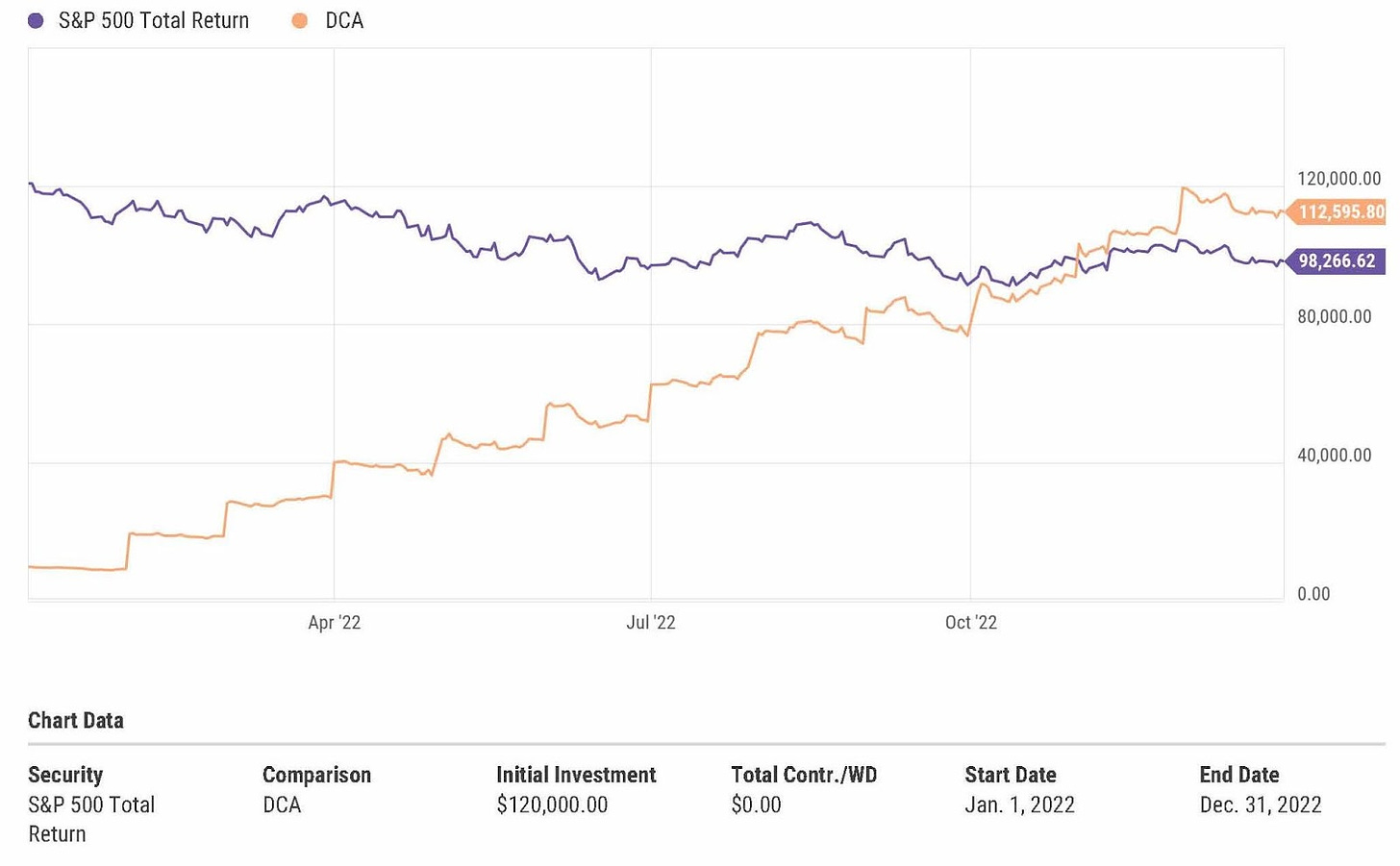Lump sum investing beats dollar cost averaging about ? of the time. Markets go up the majority of days, weeks, months, and years, so putting your money to work sooner will, on average, net you the most money. However, there are risks to lump sum investing. What if the market drops significantly right after you put your money to work? The entire sum is prone to every move of the market immediately. Does dollar cost averaging ever make sense?
When to dollar cost average
Dollar cost averaging mitigates the risk of investing before a downturn, and smooths your investment into the market. Rather than being immediately 100% invested in the market, you gradually dip your toes into the water, then your feet, then your legs, and so-on until you are fully submersed. We don’t have to go too far back to look at an example of when it would be better to dollar cost average.
Per YCharts scenario builder tool, someone investing $10,000 each month into the S&P 500 last year would end the year with $112,596. Someone investing $120,000 at the beginning of 2022 would instead end the year with $98,267, over $14,000 (or 13%) less. On larger sums of money, the difference could be in the hundreds of thousands of dollars.

Chances are you won’t be investing right before a major downturn in the stock market, but there is no way to know. On larger sums of money, lump sum investing may not be worth the risk. If you are investing a significant, life-changing sum of money, consider dollar cost averaging your investment instead of lump sum investing. Think like an inheritance, money from selling a business, lottery winnings, or something similar.
If you do decide to dollar cost average, you generally want to invest your money over a period of no more than 8-12 months. This is long enough to dampen the blow of any potential market drops, but short enough so that you don’t completely miss out on significant upswings in the market.
We all dollar cost average
We don’t believe that dollar cost averaging should only be used when you come into significant sums of money – in fact, you probably dollar cost average into the market right now. If you are contributing to an employer-sponsored retirement plan or other type of retirement plan, chances are you have money being invested every single month without thinking about it. While investing monthly is awesome, there are some scenarios where it does make sense to lump sum invest and put all of your money to work at once.
When lump sum makes sense
If you are debating whether to invest a sum of money all at once or dollar cost average it, the first thing you need to consider is how big the lump sum is. If the lump sum is an annual Roth IRA or HSA contribution, it is generally not significant enough to warrant dollar cost averaging (if you are able to maximize your Roth IRA and HSA at the beginning of each year, it will work out more often than not, based on historical market returns). However, dollar cost averaging could still be beneficial for these accounts if you are behaviorally more likely to invest the same amount monthly rather than one lump sum contribution at the beginning of the year.
If your lump sum is more considerable, contemplate how it would affect you if the market drops 30% right after you invest the lump sum. For example, someone with a $2 million portfolio might receive an inheritance of $100,000 and want to know if they should dollar cost average it. If the market drops by 30% right after they invest it, that lump sum investment is down $30,000 – just a fraction of the size of their overall portfolio.
Someone with only $10,000 invested may feel differently if they receive an inheritance of $100,000. Consider the size of your lump sum investment relative to your net worth and total investable portfolio. Keep in mind that more often than not, lump sum investing is going to work out (the market is positive 73% of the time annually, and choosing lump sum investing generates excess returns of about 1.5% to 2.4%, on average). Dollar cost averaging is a risk mitigation tool and can offer some protection against significant declines in the market. If you are more risk-averse or come into a significant sum of money, it is certainly worth considering.
Is dollar cost averaging or lump sum investing right for you? Check out this clip from the show where Brian and Bo debate what to do with a large sum of money. We believe that both lump sum investing and dollar cost averaging have a time and a place, and both strategies can be used in different situations. Lump sum investing is great when you have a non-life-changing amount of money you want to put to work as quickly as possible, and dollar cost averaging is useful when avoiding worst-case scenarios is of utmost importance.













